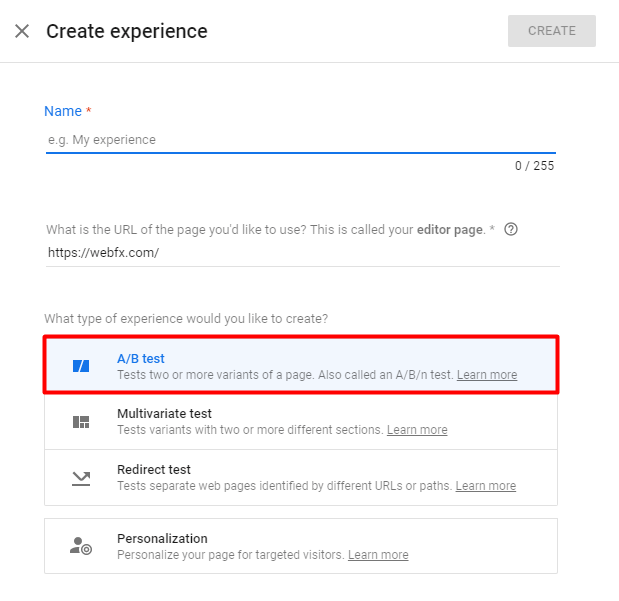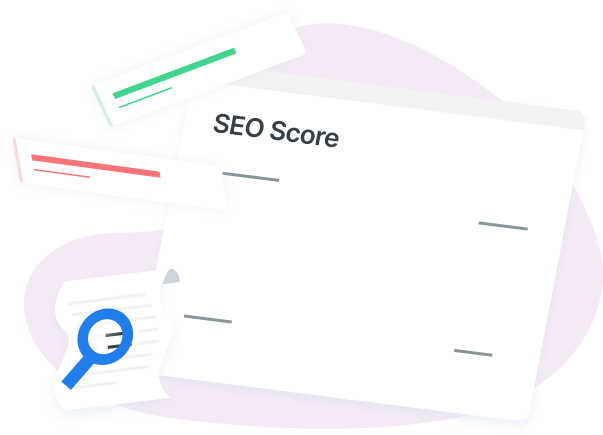-
 8 min. read
8 min. read
-
 Trevin Shirey
Trevin Shirey VP of Marketing
VP of Marketing
- Trevin serves as the VP of Marketing at WebFX. He has worked on over 450 marketing campaigns and has been building websites for over 25 years. His work has been featured by Search Engine Land, USA Today, Fast Company and Inc.
Wouldn’t it be convenient to try on different titles, meta descriptions, and linking practices to see what enhances your search engine optimization (SEO) campaign? You can with SEO testing — and it doesn’t have to drain your entire marketing budget when you have free tools and an easy-to-follow guide. To achieve top rankings, test drive a variety of SEO-focused options on your pages.
Could you use an experienced team of SEO experts to perform a thorough SEO audit now?
Contact WebFX online or call us at 888-601-5359 to speak with a specialist and boost your SEO performance. Keep reading to learn more about how to run SEO tests on your site and use our search engine optimization test tool (included below) to test your SEO instantly!
What is SEO testing?
SEO testing is the process of evaluating the best steps to optimize your pages for the search engine results pages (SERPs). Essentially, you’re experimenting to find out how to improve your SEO strategy and gain results.
Split or A/B testing is the go-to way to weigh the possibilities for your SEO strategy. Split testing takes place by dividing traffic to two different versions of the same page. As people interact with the separate pages, you can collect data — usually conversions through desired actions — about which page is more effective.
How to run SEO tests
SEO tester software is generally used to run SEO tests and track the distinct actions of users in each version, but Google Optimize offers free, accessible SEO testing.
Within Google Optimize, you can add variants of a page, gather important analytics, and set objectives.  There are additional tests available in Google Optimize like multivariate testing and redirect testing, but for our purposes, let’s stick with A/B split testing. Want to try a free SEO checker now?
There are additional tests available in Google Optimize like multivariate testing and redirect testing, but for our purposes, let’s stick with A/B split testing. Want to try a free SEO checker now?
WebFX’s SEO tester is simple and easy to use — just type in your URL and your email to get your results!
7 SEO test ideas for your next experiment
In Google Optimize, you can perform A/B testing for plenty of specifics on your pages. But which SEO tests are critical to evaluate your website’s optimization? SEO strategies monitor numerous factors because search engines pull from the details of your site to rank their quality and relevance, so experiment with the following seven details in your split tests.
1. Compare title tags
Since users are confronted with the title on your two battlefronts — the SERPs and your actual pages — your title tag is a big deal. SEO testing for titles includes altering the length, wording, and emotional appeal, as well as keyword targeting. Even switching out a few choice words in your title transforms user responses.
For product pages, that might be a reference to a special service like free shipping. On blog posts and guides, it could be a catchy phrase like “ultimate tutorial” or “best [insert product] according to the experts.” The feedback on title tags can let you better grasp search intent, the reason people enter the words they do in the search bar. In later content creation, you can aim for relevant titles and materials for your audience.
You can watch your click-through rate after you’re through with split testing and enjoy the benefits of picking the right title.
2. Change header tags
Similarly to title tags, header tags can make a unique first impression on users. They also tip off search engines about the main subject of your page — not to mention, they’re the cherry on top of the information hierarchy.  H1 tags are the on-page titles that visitors read upon arrival, and if it’s enticing enough, the H1 header tag can increase dwell time — the length of time users spend looking at your page before heading back to Google’s results page.
H1 tags are the on-page titles that visitors read upon arrival, and if it’s enticing enough, the H1 header tag can increase dwell time — the length of time users spend looking at your page before heading back to Google’s results page.
You can plug power words into your headers, too. Try out the following types of eye-catching words to draw in more attention:
- Limited-time words: Now, exclusive, hurry
- Startling descriptors: Amazing, innovative, excellent
- Brand-new signals: Latest, new, breakthrough
- Budget-friendly phrases: Free, discount, deal, low price
Depending on your target customers, these words can help or hurt you. For instance, if you have high-end goods, you won’t mention “free” or “affordable” in your headers or titles. Split tests for SEO can fill in the gaps in your SEO strategy and ensure that your content resonates with potential customers.
3. Differentiate linking
Internal linking in your content can lead visitors to other useful pages on your site that interest them. The question for SEO testing is where should you place links on pages, what kind of anchor text you should use, and how many should exist on each page. You can test whether your link should appear at the top or middle of the page to judge which gets surges of clicks.
If you mention a core product in a post, should you put the reference and link in the first couple sentences or a few paragraphs down? SEO test results reveal some mystery behind link functionality in your content and user behavior.
4. Contrast layouts
Engaging page design improves user experience with amplified site quality and rankings. Clean, impressive layouts can either guide the eyes effortlessly down the page or fail to retain visitors — and SEO testing can determine which your current design is. You can select your two layouts from a range of column widths, appealing fonts, and color schemes.
However, you’ll probably only make minor changes in layout rather than substantive design modifications. Consider split testing your buttons and forms, too, during layout checks. Implementing an SEO tester for design can control the path that people take as they scan your content, giving you a higher chance of converting users.
5. Switch out images
Visuals are SEO gold — as long as they’re optimized and do their job. But which images keep people around on your site? SEO tests for images help you avoid easy mistakes and land on the most relatable pictures.
It can pinpoint what size, sharpness, placement, and central focus your visitors prefer. For example, using a picture featuring a person tends to bring positive results like higher conversion rates. It’s helpful to step into someone else’s shoes, even if it’s just a basic photo.

6. Shake up copy length
As you check your SEO, you can’t overlook content — it’s the reigning “king,” remember? Because it defines such a significant portion of your SEO condition, you need to go over it in SEO testing. The word count on your pages is something to look out for.
What’s the average length of your articles and service pages? It’s not as simple as cranking out immense word counts — you need to thoroughly discuss your topic and assist visitors. While in-depth content is perfect for ranking competitively, 3000-word posts are not always successful at retaining attention.
When you’re in a rush to learn how to change a tire, will you stay on an extra-long article or return to the SERPs for a concise answer? You can find the sweet spot of copy length by running SEO tests on your blogs, how-to articles, and product pages.
7. Tweak CTAs
To finish up this SEO testing tutorial, it’s time to talk about call-to-actions (CTAs). CTAs have to reel your visitors in without pressuring them — it’s a difficult balance that SEO testing can clear up. Compare CTAs that sneak in at the start of your content and CTAs that finish off your page.
A prominent space can quickly convert visitors in many cases, so set up a split test to decide on the most profitable course. You can also change the level of urgency in your CTA messages. How ready are users to buy your services and products?
If they’re sliding down the sales funnel, you can snatch their transactions with an urgent CTA.
Get started with SEO testing from WebFX
SEO testing is necessary to win high rankings and stimulate traffic. With this free SEO testing tutorial, you have exactly what you need to hone your strategy and create lucrative progress. Another essential to advance your campaign is a masterful SEO agency.
When it comes to SEO, WebFX is the best company to drive results and generate revenue for your business. Just ask our clients — they’ve left us 1,100+ testimonials. In the last five years, we’ve generated $6 billion in client revenue and driven over 255,000 page one rankings on Google — it’s obvious we care about real results.
With WebFX, you also get the benefit of MarketingCloudFX, our proprietary software that allows you to test different SEO-transforming options on your pages. It’s free for our clients! Are you interested in boosting your traffic and benefiting your bottom line?
Contact us online or call us at 888-601-5359 today.
-
 Trevin serves as the VP of Marketing at WebFX. He has worked on over 450 marketing campaigns and has been building websites for over 25 years. His work has been featured by Search Engine Land, USA Today, Fast Company and Inc.
Trevin serves as the VP of Marketing at WebFX. He has worked on over 450 marketing campaigns and has been building websites for over 25 years. His work has been featured by Search Engine Land, USA Today, Fast Company and Inc. -

WebFX is a full-service marketing agency with 1,100+ client reviews and a 4.9-star rating on Clutch! Find out how our expert team and revenue-accelerating tech can drive results for you! Learn more
Try our free SEO Checker
Boost your site’s search performance with our free SEO Checker. Analyze your website for optimization tips on titles, headers, content, speed, and more. Get a free report now to enhance rankings on Google, Bing, Yahoo, and beyond!



How Is Your Website’s SEO?
Use our free tool to get your score calculated in under 60 seconds.
Try our free SEO Checker
Boost your site’s search performance with our free SEO Checker. Analyze your website for optimization tips on titles, headers, content, speed, and more. Get a free report now to enhance rankings on Google, Bing, Yahoo, and beyond!






